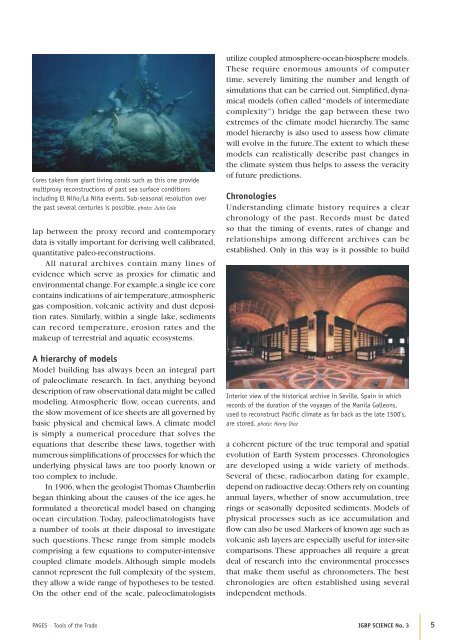Environmental Variability and Climate Change
Environmental Variability and Climate Change
Environmental Variability and Climate Change
Create successful ePaper yourself
Turn your PDF publications into a flip-book with our unique Google optimized e-Paper software.
Cores taken from giant living corals such as this one provide<br />
multiproxy reconstructions of past sea surface conditions<br />
including El Niño/La Niña events. Sub-seasonal resolution over<br />
the past several centuries is possible. photo: Julia Cole<br />
lap between the proxy record <strong>and</strong> contemporary<br />
data is vitally important for deriving well calibrated,<br />
quantitative paleo-reconstructions.<br />
All natural archives contain many lines of<br />
evidence which serve as proxies for climatic <strong>and</strong><br />
environmental change. For example, a single ice core<br />
contains indications of air temperature, atmospheric<br />
gas composition, volcanic activity <strong>and</strong> dust deposition<br />
rates. Similarly, within a single lake, sediments<br />
can record temperature, erosion rates <strong>and</strong> the<br />
makeup of terrestrial <strong>and</strong> aquatic ecosystems.<br />
A hierarchy of models<br />
Model building has always been an integral part<br />
of paleoclimate research. In fact, anything beyond<br />
description of raw observational data might be called<br />
modeling. Atmospheric fl ow, ocean currents, <strong>and</strong><br />
the slow movement of ice sheets are all governed by<br />
basic physical <strong>and</strong> chemical laws. A climate model<br />
is simply a numerical procedure that solves the<br />
equations that describe these laws, together with<br />
numerous simplifi cations of processes for which the<br />
underlying physical laws are too poorly known or<br />
too complex to include.<br />
In 1906, when the geologist Thomas Chamberlin<br />
began thinking about the causes of the ice ages, he<br />
formulated a theoretical model based on changing<br />
ocean circulation. Today, paleoclimatologists have<br />
a number of tools at their disposal to investigate<br />
such questions. These range from simple models<br />
comprising a few equations to computer-intensive<br />
coupled climate models. Although simple models<br />
cannot represent the full complexity of the system,<br />
they allow a wide range of hypotheses to be tested.<br />
On the other end of the scale, paleoclimatologists<br />
utilize coupled atmosphere-ocean-biosphere models.<br />
These require enormous amounts of computer<br />
time, severely limiting the number <strong>and</strong> length of<br />
simulations that can be carried out. Simplifi ed, dynamical<br />
models (often called “models of intermediate<br />
complexity”) bridge the gap between these two<br />
extremes of the climate model hierarchy. The same<br />
model hierarchy is also used to assess how climate<br />
will evolve in the future. The extent to which these<br />
models can realistically describe past changes in<br />
the climate system thus helps to assess the veracity<br />
of future predictions.<br />
Chronologies<br />
Underst<strong>and</strong>ing climate history requires a clear<br />
chronology of the past. Records must be dated<br />
so that the timing of events, rates of change <strong>and</strong><br />
relationships among different archives can be<br />
established. Only in this way is it possible to build<br />
Interior view of the historical archive in Seville, Spain in which<br />
records of the duration of the voyages of the Manila Galleons,<br />
used to reconstruct Pacifi c climate as far back as the late 1500’s,<br />
are stored. photo: Henry Diaz<br />
a coherent picture of the true temporal <strong>and</strong> spatial<br />
evolution of Earth System processes. Chronologies<br />
are developed using a wide variety of methods.<br />
Several of these, radiocarbon dating for example,<br />
depend on radioactive decay. Others rely on counting<br />
annual layers, whether of snow accumulation, tree<br />
rings or seasonally deposited sediments. Models of<br />
physical processes such as ice accumulation <strong>and</strong><br />
fl ow can also be used. Markers of known age such as<br />
volcanic ash layers are especially useful for inter-site<br />
comparisons. These approaches all require a great<br />
deal of research into the environmental processes<br />
that make them useful as chronometers. The best<br />
chronologies are often established using several<br />
independent methods.<br />
PAGES – Tools of the Trade IGBP SCIENCE No. 3 5

















